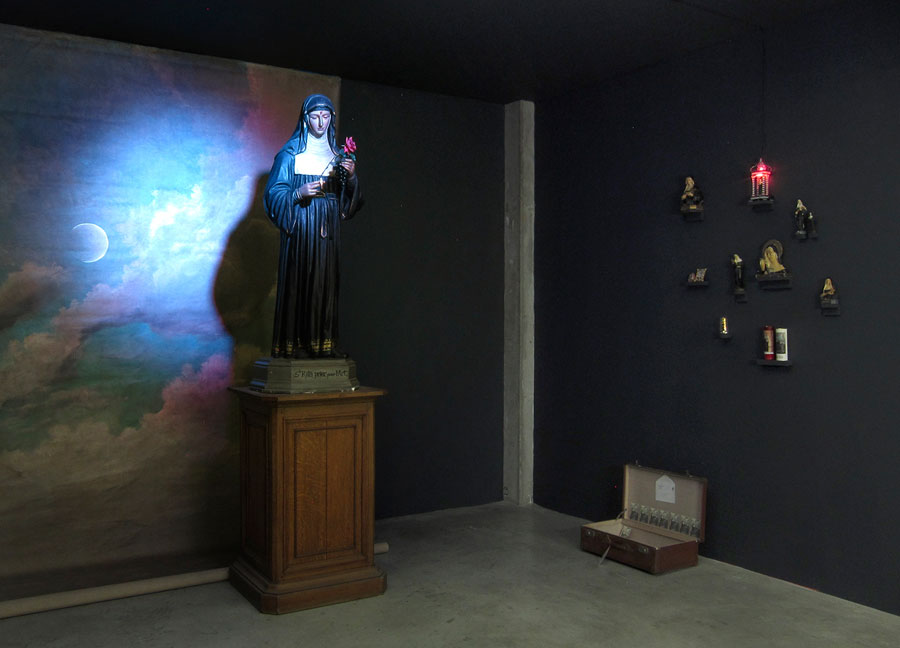Jacques Charlier has also, for a long time, investigated this artificial ideal of transubstantiation, observer of the theologies of art, of the redeeming art object, of its appropriation by the market, capable, he says, to transform the slightest air current in a transfigured object, under the strategist eye of a global Curie.
The art scene is like a temple. It has its priests, preachers, Pharisees and publicans and a growing crowd of followers. “The churches and cathedrals have emptied while museums were erected, says Charlier. These legitimize the realities of the market, accumulate the consumer goods which collectors, in turn, take ownership of. As an extraordinary act of faith, the slightest breeze can, in this way, attain the status of transubstantiation, be resurrected, saved from Apocalypse. In addition, our concept of death has changed: we now need to construct in real time. This resurrection of the body, of the glorified bodies of Christianity, is a race toward youth. And the Eucharist, the Christian body, is the art object, a redemptive object. » In his hilarious “Lettre à un amateur d’art d’actuel” (Letter to a contemporary art lover), a list of recommendations to a future fifty-year-old collector, a very lucid text and hardly parodical, Jacques Charlier persists: the association with art and its acquisition, provided that the rules are applied, is a guarantee for an escape from “botox, alcohol, hair implants and other warning signs of premature senility. »
Jacques Charlier is, like Sophie Langohr, also interested in Saint-Sulpician art or its popular corollaries, and in particular in St. Rita, of whom he has collected all kinds of testimony. It is known that Francis Alÿs collects St. Fabiola, the patron saint of battered women and nurses, widows, the abused, the deceived and the divorced. Alÿs set out on a tenacious quest and collected hundreds of copies of a single portrait of the Saint, a lost work, painted by Jean-Jacques Henner, the last of the Romantics. For Jacques Charlier, it is Saint Rita, the advocate of hopeless causes, who captures his attention. Much like Yves Klein, by the way, who went to Cascia in 1961 to donate an ex-voto dedicated to the Saint to the monastery, a small Plexiglas box containing pure pigments, gold leaf and three small ingots of this precious metal: “the blue, the gold, the pink, the intangible,” writes Yves Klein on a piece of paper slipped into the ex-voto. He was undoubtedly fascinated by the miraculous power that comes with the intangible qualities of emptiness. Jacques Charlier, for his part, preferred to invoke the queen of lost causes and disappointed hopes, the saint of impossible and disillusioned dreams. He invokes her in his “Prière des Désespérés” (Prayer of the Desperate): “Saint of the humiliated, he writes, of those without status, of the incurables, the rejects, prostitutes, artists and imprisoned, who else but you to hear our distress?”. So Rita of Cascia – her name resounds like that of a star – becomes patron of the humble, the poor, the homeless, the transsexuals, the unemployed soon without benefits and all the other desperates. Without doubt, it is the media image of Rita that attracted Jacques Charlier. Just think that, at birth, a swarm of white bees swirled around the cradle of Rita, putting honey in her mouth. The population of Cascia has reported many signs and inexplicable wonders since her death in 1457. Rome beatified her in 1627, at which time Cardinal Fausto Poli initiated an exemplary media campaign. Pope Leo XIII canonized her in 1900. Today, the Saint has her own Facebook page, her own official websites, her unofficial sites and, of course, her online business. Barely a year ago, the French newspaper La Voix du Nord ran a headline on the pilgrimage to Vendeville where, since 1923, she is credited with a healing miracle: “With the crisis, every day 300 people come to pray to St. Rita in Vendeville. » Sign of the times.
The Saint first appears in Jacques Charlier’s work in 1991. He places a large polychrome plaster statue of Rita of Cascia on a base. In lavish Sulpician style, she holds a rose in one hand, a bunch of grapes in the other. It is the rose that bloomed in the middle of winter upon her death and the grapes of a dead vine she patiently watered until it eventually bore fruit, because, for Rita, nothing is impossible. The backdrop of this theatre of objects is celestial and crepuscular; words here swarm like gleams of light: certitude, appeasement, quietude, forgiveness, healing, grace, calm.
Among them, the three letters of the word Art. The artist adds, moreover, a third attribute to the Saint: an easel. Disenchantment with art, the instrumentalisation of its history and the market: Charlier stakes everything on the intervention of the holy miracle-worker.
A second petition, in 1993, allows him to be even more explicit: he creates an installation with a canvas depicting a dark immensity, a cup of grapes, a whip for self-mortification and a statue of the saint. This time, like a dedicator, he supports his plea: “St. Rita, pray for art.” Finally, this year, on the occasion of « Kontakt 93 », he presents a monumental Rita in the park of Eupen. The polychrome plaster statue comes directly from Cascia in Umbria. It is set on an impressive pedestal. In her hands, St. Rita holds a crucifix, a reminder of the stigma of the thorn in her forehead.
In Cascia, the body of the Saint rests in a shrine made of glass and silver. In 1682, according to tradition, her incorruptible body apparently lifted to touch the top of the shrine. Jacques Charlier puts the Saint upright again. In this way, she extends her blessings to the park, standing in a vertical casket. And every night, the unemployed youth of the neighbourhood come to drink cans of beer at her feet.
[sociallinkz]
